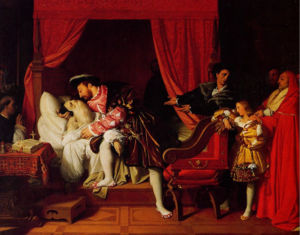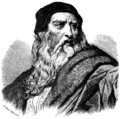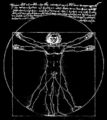- Cultural depictions of Leonardo da Vinci
-
Main article: Leonardo da Vinci
Leonardo da Vinci 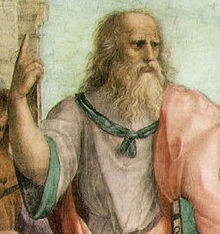
Raphael's depiction of Plato in his famous fresco "The School of Athens" in the Vatican is believed to be an image of Leonardo da Vinci.Birth name Lionardo di Ser Piero da Vinci Born April 15, 1452 Anchiano, Province of Florence, in modern-day Italy 
Died May 2, 1519
Amboise, Indre-et-Loire, in modern-day France
Nationality Italian Field Many and diverse fields of arts and sciences Movement High Renaissance Works Mona Lisa, The Last Supper, The Vitruvian Man Leonardo da Vinci (15 April 1452 – 2 May 1519) was an Italian Renaissance painter and polymath who achieved legendary fame and iconic status within his own lifetime. His renown primarily rests upon his brilliant achievements as a painter, the Mona Lisa and the Last Supper, being two of the most famous artworks ever created, but also upon his diverse skills as a scientist and inventor. He became so highly valued during his lifetime that the King of France bore him home like a trophy of war, supported him in his old age and, according to legend, cradled his head as he died.
Leonardo's portrait was used, within his own lifetime, as the iconic image of Plato in Raphael's School of Athens. His biography was written in superlative terms by Vasari. He has been repeatedly acclaimed the greatest genius to have lived. His painting of the Mona Lisa has been the most imitated artwork of all time and his drawing of the Vitruvian Man iconically represents the fusion of Art and Science.
Leonardo's biography has appeared in many forms, both scholarly and fictionalised. Every known aspect of his life has been scrutinised and analysed. His paintings, drawings and notebooks have been studied, reproduced and analysed for five centuries. The interest in and appreciation of the character of Leonardo and his talents has never waned.
Leonardo has appeared in many fictional works, such as novels, television shows and movies, the first such fiction dating from the 16th century. Various characters have been named after him.
Contents
In art
Self portrait
The well-known portrait that is generally accepted as being of Leonardo da Vinci is certainly by his hand, but is not universally accepted as a self-portrait because the man depicted appears to be older than Leonardo was at his death. It has been suggested that it is Leonardo's portrait of his father or grandfather. On the other hand, an explanation that has been put forward to explain the apparent advanced age of the individual is that Leonardo deliberately drew himself as older than he really was, in order that Raphael might use it as the basis for his depiction of Leonardo as Plato in the School of Athens.
The drawing has been the basis for other representations of Leonardo.
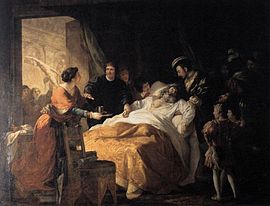 Ménageot's The Death of Leonardo da Vinci
Ménageot's The Death of Leonardo da Vinci
Death of Leonardo
The story of Leonardo dying in the arms of the French king Francis I, although apocryphal,[1] appealed to the self-image of later French kings and to French history painters of the 18th and 19th centuries.
Apparently on commission from Louis XVI,[2] Ménageot painted The Death of Leonardo da Vinci in the arms of Francis I in 1781, setting it in a background of classical statuary. Thie painting, which was the triumph of the Salon of 1781, included a portrayal of the Borghese Gladiator (Ménageot probably having seen it at the Villa Borghese during his stay at the French Academy in Rome from 1769 to 1774), although this was an anachronism since Leonardo died in 1519, about ninety years before the statue was discovered.
In 1818 the French painter Jean Auguste Dominique Ingres depicted the scene of Leonardo's death which is shown taking place in the home Clos Lucé provided for him at Amboise by King Francis I. The King is shown supporting Leonardo's head as he dies, as described by Vasari, watched by the Dauphin who is comforted by a cardinal. A distraught young man may represent Leonardo's pupil Melzi.
The treatment of this subject by Ingres is indicative of Leonardo's iconic status and also specifically that he was of particular significance to the school of French Classicism. A number of his paintings had passed into the Royal collection and certain elements of them were much imitated. Leonardo's manner of soft shading known as Sfumato was particularly adapted by Ingres, Jacques Louis David and their followers. An influential painting was Leda and the swan, now regarded as by a pupil of Leonardo but then generally accepted as the master's work.
Biography and appraisal
Vasari
Television documentary
In fiction
Novels and short stories
- The Romance of Leonardo da Vinci (1901) by Dmitry Merezhkovsky.
- The Second Mrs. Giaconda (1975) by E. L. Konigsburg is a children's novel about why Leonardo painted the Mona Lisa.
- Leonardo Da Vinci: Detective a short story by Theodore Mathieson, portrays him using his genius to solve a murder during his time in France.
- Pasquale's Angel by Paul J. McAuley, set in an alternate universe Florence, portrays Leonardo as "the Great Engineer", creating a premature industrial revolution (see clockpunk).
- The novel The Memory Cathedral by Jack Dann is a fictional account of a "lost year" in the life of Leonardo. Dann has his genius protagonist actually create his flying machine.
- The novel Pilgrim by Timothy Findley describes the encounters of an immortal named Pilgrim with Leonardo da Vinci among others, as told to Carl Jung.
- Terry Pratchett's character Leonard of Quirm is a pastiche of Leonardo.
- Three novels by Martin Woodhouse and Robert Ross feature the adventures of Leonardo da Vinci in the guise of a James Bond-type spy of the Italian Renaissance: The Medici Guns (1974); The Medici Emerald and The Medici Hawks.
- The Secret Supper (2006) by Javier Sierra explores the symbology of Leonardo's Last Supper, and its threat to the Catholic Church, as he is painting the fresco in 15th century Milan.
- Black Madonna (1996) by Carl Sargent and Marc Gascoigne, is set in the Shadowrun game universe and portrays Leonardo as still living in the 21st century, blackmailing corporations to finance his inventions.
- The Medici Seal, a children's novel by Theresa Breslin (2006).
- In the Children of the Red King series, a Donatella Di Vinci married a Bertram Babbington-Bloor. Donatella was the daughter of an Italian magician. No connection between Leonardo and Donatella has been stated since.
- In Robert Heinlen's The Door Into Summer, Dr. Twitchell recounts a tale of a student whom he displaced in time by 500 years. While there was no way of knowing whether the student went to the past or the future, Dr. Twitchell hints that he believes it was the past due to the student's name—Leonard Vincent.
- The Ground is Burning by Samuel Black explores the intersection of Leonardo's life with those of Niccolò Machiavelli and Cesare Borgia.
- Leonardo Da Vinci is a significant character in the novels; Assassin's Creed: Renaissance and Assassin's Creed: Brotherhood (novel), books based on the video game series Assassin's Creed. Leonardo is portrayed as a close friend of the protagonist, Ezio Auditore da Firenze, a Florentine nobleman's son who joined the Assassin Brotherhood after the murder of his father and brothers by the ruling families of Italy, each part of of the once thought disbanded Knight's Templar. Leonardo helps the assassin decipher encrypted codex pages left behind by legendary master assassin, Altair (the protagonist of the original Assassin's Creed game). Leonardo's flying machine is successfully built and helps Ezio travel across Venice in order to assassinate one of his targets.
The Da Vinci Code
This work of fiction has been the centre of controversy over the accuracy of its depictions of Christianity and of Leonardo.
A bestselling 2003 novel by Dan Brown, adapted and released as a major motion picture in 2006, The Da Vinci Code revolves around a conspiracy based on elements of Leonardo's Last Supper and other works. A preface to the novel claims that depictions of artworks, secret societies and rites described within the novel are factual. For this reason much of the content of the novel has been widely accepted by readers as authoritative. Because the theme involves a conspiracy within the Church over the life of Jesus and the suggestion that the Church has hidden the facts of his marriage, there has been a strong reaction against the novel and much material published examining and refuting its claims.
Within the novel it is claimed that from 1510–1519, Leonardo was the Grand Master of a secret society, the Priory of Sion. In reality this society existed only as a 20th century hoax, but author Dan Brown used as a source the 1982 pseudohistory book The Holy Blood and the Holy Grail. The writers of this book had based their research on forged medieval documents that had been created as part of the Priory of Sion fraud. The mix of fact and fiction in the documents made it difficult to discount immediately as a forgery. For example, it was claimed that the Grand Master prior to Leonardo was Botticelli, who had indeed had an association with Leonardo, as they were both students at the Florence workshop of Andrea del Verrocchio.
The Priory of Sion story and the veracity of The Holy Blood and the Holy Grail was eventually debunked, and many of those involved publicly recanted, although Dan Brown continued to assert that the facts as presented were true.
In portraying the Priory of Sion as "fact" The Da Vinci Code expanded on the claims in The Holy Blood and the Holy Grail:
- That there were additional secrets hidden in Leonardo's paintings, such as an "M" letter in the painting of The Last Supper, indicating the presence of Mary Magdalene and that the figure to the left of Jesus traditionally said to represent John the Evangelist actually represents Mary Magdalene.
- That Leonardo's painting The Mona Lisa was actually a self-portrait.
- That among the differences in the two versions of the painting of the Virgin of the Rocks which hang in the Louvre and London's National Gallery, is the fact that in the Louvre painting the baby to the left of the picture depicts Jesus, and to the right John the Baptist, rather than the accepted view, which is the other way round.
- That Leonardo invented a cryptex for carrying secret messages.
The book also used a variation of Leonardo's backwards handwriting to hide a secret message on the American bookjacket.
Among the many criticisms of Brown's writing is that he uses the name da Vinci (meaning "from Vinci") in the manner that surnames are commonly used nowadays. Leonardo would never have been referred to simply as da Vinci in his lifetime. Such designations were appended to common baptismal names in order to identify individuals.
Movies
- Movies that are about the life of Leonardo or in which he appears as a character:
- Leonardo Da Vinci at the Internet Movie Database (1919), film mute
- The Life of Leonardo da Vinci (1971) starring Philippe Leroy as Leonardo da Vinci.
- Nothing Left to Do But Cry (1984) starring the academy award winner Roberto Benigni and the academy award nominated Massimo Troisi
- Quest of the Delta Knights (1993) depicting a fictional version of the young Leonardo
- Leonardo Da Vinci at the Internet Movie Database (1996) - Animated movie
- Ever After (1998) starring Drew Barrymore and Patrick Godfrey as Leonardo da Vinci
- Christie Malry's Own Double-Entry at the Internet Movie Database (2000) starring Mattia Sbragia as Leonardo da Vinci
- Leonardo at the Internet Movie Database (2003), TV movie starring Mark Rylance as Leonardo da Vinci
- Movies which refer to Leonardo's works or inventions:
- Hudson Hawk (1991) starring Bruce Willis and Danny Aiello revolves around Leonardo da Vinci's inventions
- The Da Vinci Code (2006) starring Tom Hanks
- The Da Vinci Treasure (2006) depicts Da Vinci's paintings as clues that lead to enlightenment
Theatre
- Peter Barnes's 1969 play Leonardo's Last Supper centres on Leonardo being "resurrected" in a filthy charnel house after being prematurely declared dead.
- David Davalos's 2002 play Daedalus tells a fantasized story of Leonardo's time as a military engineer in the service of Cesare Borgia.
Music
- Author Charles Anthony Silvestri and composer Eric Whitacre collaborated to create an "opera bréve" based on text from da Vinci's journals and original text by Silvestri. This piece, Leonardo Dreams of His Flying Machine, was modeled after da Vinci's conceptual flying machine. This piece was written on commission by the American Choral Directors Association as the second piece in Whitacre's series of "Element Works," the first being Cloudburst, written in 1992.
- Dream Theater vocalist James LaBrie performed as Leonardo in the progressive metal album 'Leonardo: The Absolute Man', an album which itself explored his life and works through the milieu of music.
- In the Red Hot Chili Peppers video for Californication, a cartoon John Frusciante can be seen riding Leonardo's helicopter.
Television fiction
- In the anime OVA: 'Mask of Zeguy' Leonardo da Vinci was one of the antagonists who sought out the Crown of Shamus in order to prevent Himiko from using her powers to open the Gate of Winds, because his inventions (i.e. dangerous weapons) will become useless.
- In The Super Mario Bros. Super Show! live-action segment "The Painting", the Mario Bros. find a painting which happens to be Leonardo da Vinci's painting "The Last Supper". They call up Howard Stevens (played by the show's producer Andy Heyward), and he explains that it's the "second Last Supper" by Leonardo da Vinci "Rooney". However, upon further examination, they discover that the painting is actually worthless because it was painted by an impostor, Leonard da Vinci "Mahoney". Howard was able to identify it as Mahoney's painting because one of the people in the painting is Mahoney's uncle, Roy Orbisoni Mahoney. The information dealing with da Vinci in this episode is incorrect.
- In the Star Trek: The Original Series episode "Requiem for Methuselah", Leonardo da Vinci is revealed to be one of many aliases to "Flint", an immortal man born in the year 3834 BC. Leonardo's abilities and knowledge are thus attributed to centuries of scientific and artistic study. Leonardo appears again in the Star Trek universe, in the series Star Trek: Voyager, where he and his workshop are created as a holographic simulation. Actor James Daly played Flint/Leonardo in Star Trek: The Original Series, while John Rhys-Davies portrayed Leonardo in Star Trek: Voyager. Also, in the S.C.E. (Starfleet Corps of Engineers) novellas, the main starship of the series is called the U.S.S. da Vinci (NCC-81623), a Sabre-class vessel, named for the artist.
- The 1979 Doctor Who story City of Death features a theft of the Mona Lisa. The Doctor goes back in time to visit Leonardo's workshop and claims to be an old acquaintance of the artist. Leonardo also appears as a character in several Doctor Who novels.
- The cartoon The Tick features Leonardo in "Leonardo DaVinci and his Fightin' Genius Time Commandos!" (Season 2, Episode 17, 1995) in which a number of famous inventors are brought to the present by an inventor seeking to take credit for their work. (Other inventors include Ben Franklin, George Washington Carver, and the neolithic inventor of the wheel, named Wheel.) Leonardo is portrayed as being able to create fantastic flying devices out of rudimentary objects.
- The television show Alias features a character Milo Giacomo Rambaldi, a fictional character clearly based on Leonardo.[citation needed]
- In the animated television series Dilbert episode "Art" has Leonardo as the secret ruler of the art world. He reveals that he discovered immortality centuries ago through the invention of the fountain of youth.
- An episode of Histeria! focusing on the Renaissance featured a cartoon caricature of Leonardo as a host. Over the course of the episode, he is criticized by World's Oldest Woman for wearing a dress, and also parodies the 1960s Batman series as Renaissance Man, with Loud Kiddington as his sidekick.
- Featured on the History Channel's Man, Moment, Machine.
- On the American sitcom Seinfeld. Kramer attempts to sleep for 20 minutes every hour. A polyphasic sleep pattern he claims is the way da Vinci slept during his lifetime.
- The anime Time Quest features Professor Leonardo as inventor of the kettle-shaped time machine, who is revealed to be Leonardo da Vinci in the final episodes.
- In Blackadder: Back & Forth, Baldrick builds a time machine to Leonardo's exact design specifications and it actually works.
- The Futurama episode "The Duh-Vinci Code" reveals Leonardo to be an alien from Planet Vinci, which is inhabited by brilliant intellectuals of human appearance. However, he is considered to be the least intelligent of the planet's inhabitants and is bullied by everyone else for it. He came to Earth as a means of escape, but returned after being disillusioned by how much more unintelligent the people of Earth were compared to him. He builds a new machine designed to kill his tormentors, but it is sabotaged by Philip J. Fry, and Leonardo is killed instead when he pulls a lever on the machine that drops a giant cog on him, crushing him.
- In The Borgias[disambiguation needed
 ], Leonardo is given a passing reference as the artist who doesn't finish.
], Leonardo is given a passing reference as the artist who doesn't finish. - The Family Guy episode "The Big Bang Theory" follows Stewie and Brian on a quest to stop Bertram from killing Leonardo, which would permanently erase Stewie from the universe.
- In the Ironside Season 2 episode "The Prophecy," a fictional Leonardo painting called "The Seraglio" is stolen from a museum. A psychic friend of Ironside's tells Mark Sanger he will catch "a lovely black girl all in silver and emeralds with golden rings around her ankles," and it is Mark who saves the painting--which features a bejeweled black woman dancing in a seraglio--from rolling into the sea toward the end of the episode.
Advertising
- Benetton's 1988 "United Superstars of Benetton" print and billboard campaign, paired with Julius Caesar [3]
Comics and graphic novels
- The comic strip, cartoon and movie Teenage Mutant Ninja Turtle character Leonardo is named after Leonardo da Vinci, by the comic's creators Kevin Eastman and Peter Laird who had studied art history.[4]
- The DC Comics Elseworlds story "Black Masterpiece", in Batman Annual #18, shows Leonardo's apprentice becoming a Renaissance Batman, using the Master's devices in his war on Florentine crime.
- DC Comics's Vertigo division published a ten-issue miniseries about Leonardo and his apprentice Salai, entitled Chiaroscuro: The Private Life of Leonardo da Vinci.
- In the mainstream DC Universe, according to Secret Origins #27, Leonardo is an ancestor of the famed Freemason Cagliostro, as well as Zatara and Zatanna who are both magicians (in the Magic (illusion) and Magic (paranormal) senses) and Superheroes. Also, in Final Night #2, it was revealed that Vandal Savage had blackmailed Leonardo into painting the Mona Lisa.
- The Dargaud cartoon character Léonard by Turk and De Groot.
- Général Leonardo, a French-language graphic novel by Erik Svane and Dan Greenberg in two Paquet volumes (so far), In the Service of the Vatican and Crusade To the Holy Land.
- The Daily Mirror comic strip character Garth saved Leonardo from the Black Death in the 1972 strip Orb of the Trimandias, written by Jim Edgar and illustrated by Frank Bellamy.
- A Mickey Mouse comic book from 1986 includes a story titled The Return Of Limonardo where Huey, Dewey and Louie meet Limonardo da Vimsi, based on Leonardo.[5]
- In 1979, the French weekly Journal de Mickey published a Mickey Mouse adventure based in Renaissance Florence. Goofy is Leonardo, and Mickey gets him to paint the portrait of Mona Lisa, who is represented by Clarabelle Cow.
- Leonardo appeared as a character in the now defunct Marvel Comics imprint Epic Comics mini series The Light and Darkness War.
- Leonardo Da Vinci appears in the current Marvel S.H.I.E.L.D. series (Which is now a series of mini series) by Jonathan Hickman. Leonardo is dipicted as a leader of the a sacred order called the Brotherhood of the Shield and has been shown to time travel to the story's "present" set in the late 1950s and early 1960s.
Computer and video games
- The Secrets of Da Vinci: the Forbidden Manuscript – the first game about the life and work of Leonardo da Vinci.[1]
- In Rise of Legends (2006), the Vinci faction uses steampunk technology inspired by Leonardo.
- In Soul Calibur Legends there is a character that bears a striking resemblance to Leonardo, and even has the same Name .
- In Elite Beat Agents, one mission has the agents go back in time to help Leonardo paint the Mona Lisa. He is only ever referred to as "Leo" or "Leonard".
- Leonardo is an important supporting character in Assassin's Creed II and its sequels. In the first game a young Leonardo befriends the protagonist, Ezio Auditore da Firenze, in 1476 when introduced by Ezio's mother Maria, a patron of Leonardo's. He later helps Ezio by deciphering pages of an ancient Assassin Codex and using his mechanical know-how to build various various devices, inventions and weapons. An older Leonardo appears in Assassin's Creed: Brotherhood, having been forced to make war machines for Cesare Borgia and Rodrigo Borgia and asking Ezio to help him by destroying them. In the DLC The Da Vinci Disappearance for Brotherhood, Leonardo is kidnapped by Hermeticists, members of the Cult of Hermes, and Ezio must rescue him. The DLC also includes Leonardo's pupil, Salaì.
Role-playing games
In Warhammer Fantasy Roleplay, there is an equivalent to Leonardo named Leonardo de Miragliano.
Depictions of Leonardo's works
 Peter Paul Rubens' copy of the lost Battle of Anghiari.
Peter Paul Rubens' copy of the lost Battle of Anghiari.
Pupils and followers
Leonardo's pupils and followers copied or closely imitated many of his pictures. Several of his important works exist only as copies by his admirers. These include:
- His cartoon of The Virgin and Child with St Anne and St John the Baptist copied as an oil painting by Bernardo Luini.
- The Battle of Anghiari was copied several times by unknown Florentine artists as well by Peter Paul Rubens.
- Leda and the Swan exists only as copies in the Louvre and Villa Borhgese.
Other much much-copied works include:
- Mona Lisa for which Angela della Chiesa cites 14 examples of which 6 are bare-breasted. These include paintings by Luini, Salai and Joos van Cleeve.
- John the Baptist for which there exist at least 5 versions by other hands including Salai.
Imitators and satirists
No painting has been more imitated and satirised than the Mona Lisa. Beginning possibly with a naked portrait of Diane de Poitiers by Clouet, the pose and expression have been freely adapted to many female portraits.
Re-creation of lost works
"Il Gran Cavallo". This monumental bronze horse, 7 metres (24 feet) high, is a conjectural re-creation of a clay horse that was created in Milan by Leonardo da Vinci for the Duke Ludovico il Moro and was intended to be cast in bronze. Leonardo never finished the project because of war with France, and the clay horse was ruined. This representation was based on a number of Leonardo's preparatory drawings. It was created in 1999 in New York and given to the city of Milan.
Presentation of existing works
The Last Supper is to be the subject of an animation by British film-maker, Peter Greenaway, who plans to project interpretative images onto its surface to enliven the scene in which the apostles all question Jesus' statement that one of them will betray him.[6]
Products and advertising
- Mona Lisa postage stamp, Germany.
Galleries
Representations of Leonardo
-
Statue of Leonardo in Amboise
Representations of Leonardo's works
-
The Last Supper carved in salt in the Wieliczka Salt Mine
-
Gioconda.jpg
See also
- Leonardo da Vinci
- Leonardo da Vinci - scientist and inventor
- Leonardo da Vinci's personal life
- Leonard of Quirm
References
- ^ King Francis cannot have been present because the day after Leonardo's death, a royal edict was issued by the King at Saint-Germain-en-Laye, a two-day journey distant from Clos Luce.
- ^ According to François-Charles Joullain fils, Réflexions sur la peinture et la gravure 1786:2.
- ^ "Benetton Group: Evolution of Communication Strategy" scribd.com Accessed 21 February 2010
- ^ How it all Began!
- ^ The Return Of Limonardo
- ^ http://arts.guardian.co.uk/art/news/story/0,,2256943,00.html Robert Booth, Greenaway prepares to create Da Vinci coda, The Guardian, 15 February 2008
External links
- Leonardo da Vinci (Character) at the Internet Movie Database
- LOGO by Leonardo da Vinci to download and print (poster, t-shirt)
Leonardo da Vinci Paintings †Medusa · **The Baptism of Christ · The Annunciation · *Ginevra de' Benci · *The Madonna of the Carnation · *Benois Madonna · St. Jerome in the Wilderness · The Adoration of the Magi · The Virgin of the Rocks (Louvre version) · *Lady with an Ermine · *Portrait of a Musician · *Madonna Litta · *La belle ferronnière · The Last Supper · *Madonna of the Yarnwinder · Mona Lisa · Head of a Woman · The Virgin of the Rocks (London version) · †The Battle of Anghiari · †Leda and the Swan · The Virgin and Child with St. Anne · *Salvator Mundi · St. John the Baptist · *Bacchus
Sculpture Leonardo's horse (unexecuted)Works on paper Manuscripts Codex Arundel · Codex Atlanticus · Codex on the Flight of Birds · Codex Leicester · Codex Trivulzianus · A Treatise on PaintingOther projects Categories:- Leonardo da Vinci
- Fiction by topic
- Representations of people in popular culture
Wikimedia Foundation. 2010.

